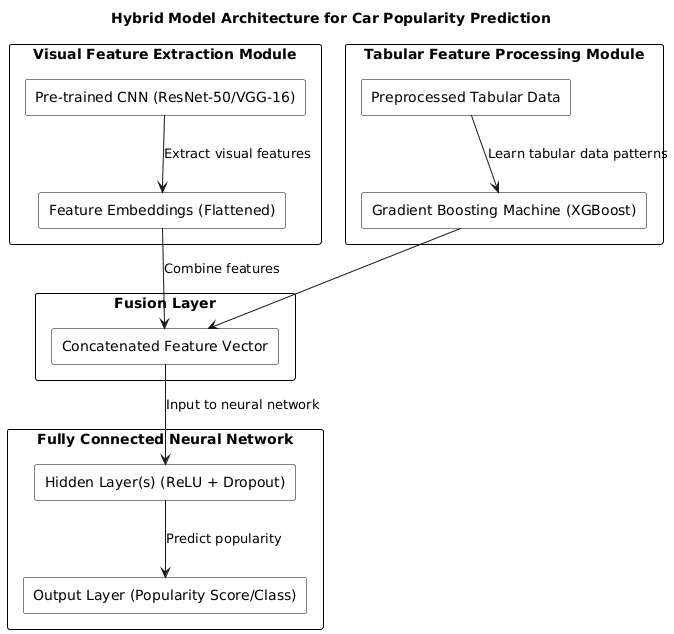A Hybrid Machine Learning Approach for Car Popularity Prediction: Integrating Visual and Tabular Data
Main Article Content
Abstract
Predicting car popularity is essential in the automotive industry to help manufacturers, marketers, and dealerships optimize product offerings and align with consumer preferences. This research introduces a novel hybrid model that combines visual and tabular data to predict car popularity, leveraging the DVM-CAR dataset with over 1.4 million images and detailed specifications for 899 car models. The model integrates a Convolutional Neural Network (CNN) for extracting visual features, such as body style and design aesthetics, with a Gradient Boosting Machine (XGBoost) for processing structured attributes like price, brand reputation, and customer reviews. These features are fused in a feature fusion layer and processed through a fully connected neural network, capturing cross-data relationships. Experimental results demonstrate the hybrid model’s superior performance compared to baseline models, achieving a Mean Absolute Error (MAE) of 7.65, Root Mean Squared Error (RMSE) of 9.32, and R² Score of 0.87. These results reflect significant improvements over Linear Regression (MAE: 11.45, RMSE: 14.12, R²: 0.68) and Gradient Boosting Machines (MAE: 8.94, RMSE: 10.78, R²: 0.81). The integration of visual and tabular features enhances accuracy and interpretability, providing actionable insights into car popularity determinants. While the hybrid model offers strong predictive capabilities, future research can explore incorporating real-time data, advanced deep learning techniques, and improving scalability for large-scale deployments. This study underscores the value of integrating diverse data types in predictive analytics, setting a benchmark for car popularity prediction in the automotive sector
Article Details

This work is licensed under a Creative Commons Attribution-NonCommercial 4.0 International License.
IJCERT Policy:
The published work presented in this paper is licensed under the Creative Commons Attribution 4.0 International (CC BY 4.0) license. This means that the content of this paper can be shared, copied, and redistributed in any medium or format, as long as the original author is properly attributed. Additionally, any derivative works based on this paper must also be licensed under the same terms. This licensing agreement allows for broad dissemination and use of the work while maintaining the author's rights and recognition.
By submitting this paper to IJCERT, the author(s) agree to these licensing terms and confirm that the work is original and does not infringe on any third-party copyright or intellectual property rights.
References
K. V. V. S. T. Naidu, T. S. Reddy, T. B. N. L. Keerthana, P. S. L. S. Mounika, and K. Swarna Bharathi, "Car Popularity Prediction: A Machine Learning Approach," International Journal of Innovative Research in Technology, vol. 8, no. 4, pp. 110-115, Sept. 2021.
"Machine Learning in Automotive: Pros, Cons, and Applications," PixelPlex, [Online]. Available: https://pixelplex.io/blog/machine-learning-in-automotive/. [Accessed: Dec. 5, 2024].
"Three Ways AI Is Impacting The Automobile Industry," Forbes, Apr. 19, 2022. [Online]. Available: https://www.forbes.com/sites/forbesbusinesscouncil/2022/04/19/three-ways-ai-is-impacting-the-automobile-industry/. [Accessed: Dec. 5, 2024].
"Modernizing the automotive industry: Creating a seamless customer experience," MIT Technology Review, May 25, 2023. [Online]. Available: https://www.technologyreview.com/2023/05/25/1073154/modernizing-the-automotive-industry-creating-a-seamless-customer-experience/. [Accessed: Dec. 5, 2024].
"Applying Machine Learning on automotive customer quality data to improve user experience and increase industry competitiveness," SAE Technical Paper 2022-36-0070, Feb. 10, 2023.
"Applying artificial intelligence to automotive marketing and sales," McKinsey & Company, May 2018. [Online]. Available: https://www.mckinsey.com/industries/automotive-and-assembly/our-insights/winning-tomorrows-car-buyers-using-artificial-intelligence-in-marketing-and-sales. [Accessed: Dec. 5, 2024].
"The Impact of AI and Machine Learning on Automotive Industry," GoMechanic, Mar. 2023. [Online]. Available: https://gomechanic.in/blog/impact-of-ai-and-machine-learning-on-automotive-technology/. [Accessed: Dec. 5, 2024].
A. Burnap and J. Hauser, "Predicting 'Design Gaps' in the Market: Deep Consumer Choice Models under Probabilistic Design Constraints," arXiv preprint arXiv: 1812.11067, Dec. 2018.
M. Schrage and D. Kiron, Machine learning in the automotive industry: Aligning investments and incentives. Big idea: Strategic measurement. 2018
K. V. V. S. T. Naidu, T. S. Reddy, T. B. N. L. Keerthana, P. S. L. S. Mounika, and K. Swarna Bharathi, "Car Popularity Prediction: A Machine Learning Approach," International Journal of Innovative Research in Technology, vol. 8, no. 4, pp. 110-115, Sept. 2021.
"Machine Learning in Automotive: Pros, Cons, and Applications," PixelPlex. [Online]. Available: https://pixelplex.io/blog/machine-learning-in-automotive/. [Accessed: Dec. 5, 2024].
"Feature Importance vs. Feature Selection: How are they related?" Train in Data. [Online]. Available: https://www.blog.trainindata.com/feature-selection-vs-feature-importance/. [Accessed: Dec. 5, 2024].
"Feature Selection Methods: Importance and Examples," Analytics Vidhya. [Online]. Available: https://www.analyticsvidhya.com/blog/2016/12/introduction-to-feature-selection-methods-with-an-example-or-how-to-select-the-right-variables/. [Accessed: Dec. 5, 2024].
"Top Data Science Applications in the Automotive Industry," Analytics Insight. [Online]. Available: https://www.analyticsinsight.net/data-science/top-data-science-applications-in-the-automotive-industry. [Accessed: Dec. 5, 2024].
"Feature Importance versus Feature Selection in Predictive Modeling for Formula 1 Racing," University of Twente Student Theses. [Online]. Available: https://essay.utwente.nl/101020/. [Accessed: Dec. 5, 2024].
"The Use Cases of Machine Learning in the Automotive Industry," PTC. [Online]. Available: https://www.ptc.com/en/blogs/alm/the-use-cases-of-machine-learning-in-the-automotive-industry. [Accessed: Dec. 5, 2024].
"Predictive Maintenance in the Automotive Sector: A Literature Review," Mathematical and Computational Applications, vol. 27, no. 1, p. 2, Dec. 2021.
"Feature Importance: 7 Methods and a Quick Tutorial," Aporia. [Online]. Available: https://www.aporia.com/learn/feature-importance/feature-importance-7-methods-and-a-quick-tutorial/. [Accessed: Dec. 5, 2024].
J. Huang, B. Chen, L. Luo, S. Yue, and I. Ounis, "DVM-CAR: A large-scale automotive dataset for visual marketing research and applications," in Proceedings of the IEEE International Conference on Big Data, 2022, pp. 4130–4137
G. H. Golub, C. F. Van Loan, Matrix Computations, 4th ed. Baltimore, MD, USA: Johns Hopkins University Press, 2013.
L. Breiman, "Random forests," Machine Learning, vol. 45, no. 1, pp. 5-32, 2001.
J. H. Friedman, "Greedy function approximation: A gradient boosting machine," The Annals of Statistics, vol. 29, no. 5, pp. 1189-1232, 2001





